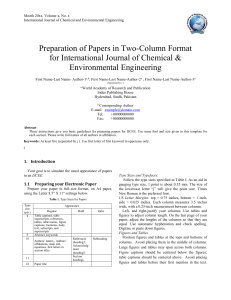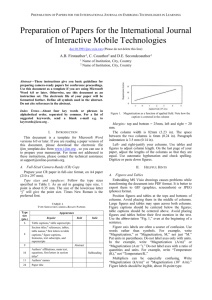Investigation of Abnormal Cell Reproduction using an Artificial Life
advertisement
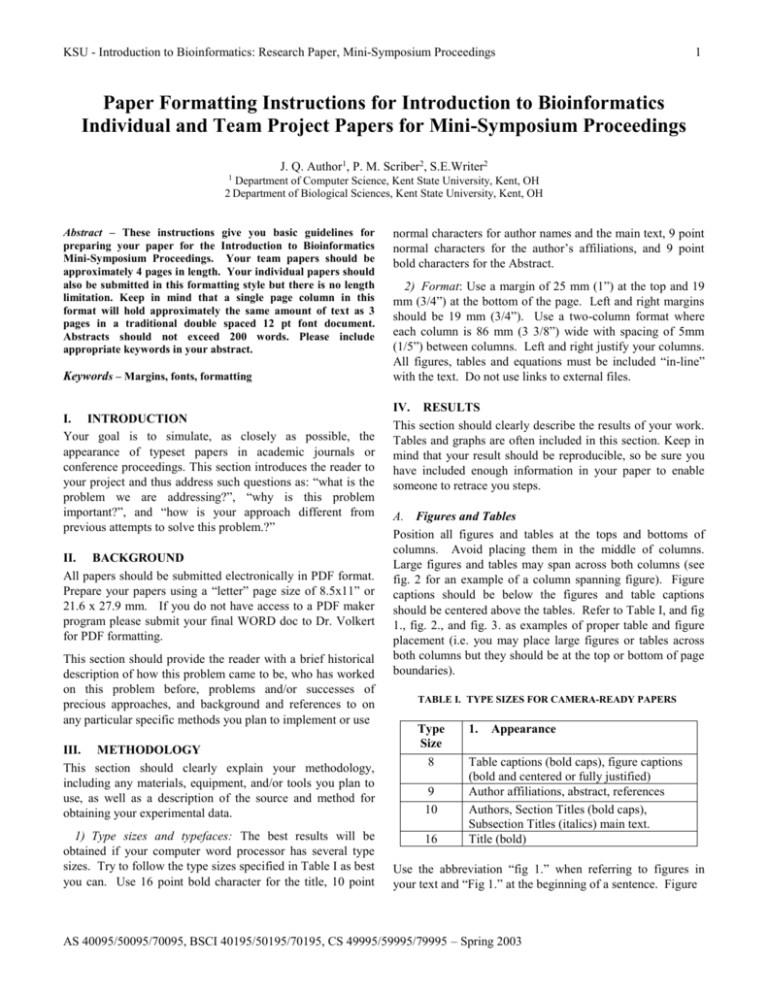
KSU - Introduction to Bioinformatics: Research Paper, Mini-Symposium Proceedings 1 Paper Formatting Instructions for Introduction to Bioinformatics Individual and Team Project Papers for Mini-Symposium Proceedings J. Q. Author1, P. M. Scriber2, S.E.Writer2 1 Department of Computer Science, Kent State University, Kent, OH 2 Department of Biological Sciences, Kent State University, Kent, OH Abstract – These instructions give you basic guidelines for preparing your paper for the Introduction to Bioinformatics Mini-Symposium Proceedings. Your team papers should be approximately 4 pages in length. Your individual papers should also be submitted in this formatting style but there is no length limitation. Keep in mind that a single page column in this format will hold approximately the same amount of text as 3 pages in a traditional double spaced 12 pt font document. Abstracts should not exceed 200 words. Please include appropriate keywords in your abstract. Keywords – Margins, fonts, formatting I. INTRODUCTION Your goal is to simulate, as closely as possible, the appearance of typeset papers in academic journals or conference proceedings. This section introduces the reader to your project and thus address such questions as: “what is the problem we are addressing?”, “why is this problem important?”, and “how is your approach different from previous attempts to solve this problem.?” II. BACKGROUND All papers should be submitted electronically in PDF format. Prepare your papers using a “letter” page size of 8.5x11” or 21.6 x 27.9 mm. If you do not have access to a PDF maker program please submit your final WORD doc to Dr. Volkert for PDF formatting. This section should provide the reader with a brief historical description of how this problem came to be, who has worked on this problem before, problems and/or successes of precious approaches, and background and references to on any particular specific methods you plan to implement or use III. METHODOLOGY This section should clearly explain your methodology, including any materials, equipment, and/or tools you plan to use, as well as a description of the source and method for obtaining your experimental data. 1) Type sizes and typefaces: The best results will be obtained if your computer word processor has several type sizes. Try to follow the type sizes specified in Table I as best you can. Use 16 point bold character for the title, 10 point normal characters for author names and the main text, 9 point normal characters for the author’s affiliations, and 9 point bold characters for the Abstract. 2) Format: Use a margin of 25 mm (1”) at the top and 19 mm (3/4”) at the bottom of the page. Left and right margins should be 19 mm (3/4”). Use a two-column format where each column is 86 mm (3 3/8”) wide with spacing of 5mm (1/5”) between columns. Left and right justify your columns. All figures, tables and equations must be included “in-line” with the text. Do not use links to external files. IV. RESULTS This section should clearly describe the results of your work. Tables and graphs are often included in this section. Keep in mind that your result should be reproducible, so be sure you have included enough information in your paper to enable someone to retrace you steps. A. Figures and Tables Position all figures and tables at the tops and bottoms of columns. Avoid placing them in the middle of columns. Large figures and tables may span across both columns (see fig. 2 for an example of a column spanning figure). Figure captions should be below the figures and table captions should be centered above the tables. Refer to Table I, and fig 1., fig. 2., and fig. 3. as examples of proper table and figure placement (i.e. you may place large figures or tables across both columns but they should be at the top or bottom of page boundaries). TABLE I. TYPE SIZES FOR CAMERA-READY PAPERS Type Size 8 9 10 16 1. Appearance Table captions (bold caps), figure captions (bold and centered or fully justified) Author affiliations, abstract, references Authors, Section Titles (bold caps), Subsection Titles (italics) main text. Title (bold) Use the abbreviation “fig 1.” when referring to figures in your text and “Fig 1.” at the beginning of a sentence. Figure AS 40095/50095/70095, BSCI 40195/50195/70195, CS 49995/59995/79995 – Spring 2003 KSU - Introduction to Bioinformatics: Research Paper, Mini-Symposium Proceedings (a) 2 (b) Figure 1: Image (a) shows a histogram of the grey scale values present in an acquired image containing a sample of bovine sperm. For different samples the sperm may be represented by grey scale values ranging from 0 to 140 depending on a variety of experimental conditions. Image (b) shows a histogram of the pixel grey scale values in the same image after application of the filters described in the text. All sperm in the image have at least a single pixel with the lowest possible grey scale value, zero. labels should be legible, about 8-point type. Fig 2. is an example of a figure containing pseudo code. Note that the font is changed to courier, which is a non-proportional font. Multipliers can be especially confusing in scientific papers. Write “Magnetization (kA/m)” or Magnetization (10 3 A/m)” to ensure that the reader knows exactly what your scale is. B. References Number citations consecutively in square brackets [1]. The sentence punctuation follows the brackets [2]. Refer simply to the reference number, as in [3]. Do not use “Ref [3]” or reference [3]” except at the beginning of a sentence: “Reference [3] was the first…”. You are strongly encouraged to use the demo ENDNOTE software for compiling your references, but this is not a requirement. Pseudo code: INITIALIZE_CELLS(); EVALUATE_CELLS(); BEGIN_LOOP NOURISH_CELLS(number,%A,%T,%C,%G); SPLIT_CELLS(); MUTATE_CELLS(); EVALUATE_CELLS(); column in which it is cited; do not put footnotes in the reference list (endnotes). Please note that the references at the end of this document are in the preferred referencing style. Give all authors’ names; do not use “et al.” unless there are six authors or more. Use a space after authors' initials. Papers that have not been published should be cited as “unpublished” [4]. Papers that have been submitted or accepted for publication should be cited as “submitted for publication” [5]. Please give affiliations and addresses for personal communications [6]. Capitalize only the first word in a paper title, except for proper nouns and element symbols. If you are short of space, you may omit paper titles. However, paper titles are helpful to your readers and are strongly recommended. For papers published in translation journals, please give the English citation first, followed by the original foreign-language citation [7]. C. Abbreviations and Acronyms Define abbreviations and acronyms the first time they are used in the text, even after they have already been defined in the abstract. Abbreviations such as IEEE, SI, ac, and dc do not have to be defined. Abbreviations that incorporate periods should not have spaces: write “C.N.R.S.,” not “C. N. R. S.” Do not use abbreviations in the title unless they are unavoidable (for example, “IEEE” in the title of this article). REPEAT UNTIL(TERMINATION_CHECK()==TRUE) Figure 2: Cell cycle pseudo code. Number footnotes separately in superscripts (Insert | Footnote).1 Place the actual footnote at the bottom of the 1 It is recommended that footnotes be avoided (except for the unnumbered footnote with the receipt date on the first page). Instead, try to integrate the footnote information into the text. V. DISSCUSION This section should compare and contrast your result and your project approach with previous work in the area and highlighting the scientific contribution of your work. For example, if you results were or were not what you anticipated suggest some appropriate follow-up experiments. Another example, discuss why your approach improves on or extends the results from a previous published approach to the same or AS 40095/50095/70095, BSCI 40195/50195/70195, CS 49995/59995/79995 – Spring 2003 KSU - Introduction to Bioinformatics: Research Paper, Mini-Symposium Proceedings a similar problem. NOTE: you may also consider combining the two previous sections into one section entitled Results & Discussion. In this case you would intersperse your discussion with each of your results. A. Other Recommendations Use one space after periods and colons. Hyphenate complex modifiers: “zero-field-cooled magnetization.” Avoid dangling participles, such as, “Using (1), the potential was calculated.” [It is not clear who or what used (1).] Write instead, “The potential was calculated by using (1),” or “Using (1), we calculated the potential.” Use a zero before decimal points: “0.25,” not “.25.” Use “cm3,” not “cc.” Indicate sample dimensions as “0.1 cm 0.2 cm,” not “0.1 0.2 cm2.” The abbreviation for “seconds” is “s,” not “sec.” Do not mix complete spellings and abbreviations of units: use “Wb/m2” or “webers per square meter,” not “webers/m2.” When expressing a range of values, write “7 to 9” or “7-9,” not “7~9.” A parenthetical statement at the end of a sentence is punctuated outside of the closing parenthesis (like this). (A parenthetical sentence is punctuated within the parentheses.) In American English, periods and commas are within quotation marks, like “this period.” Other punctuation is “outside”! Avoid contractions; for example, write “do not” instead of “don’t.” The serial comma is preferred: “A, B, and C” instead of “A, B and C.” Mutation Rate with Equal Nutritional Distribution 3 VI. CONCLUSION The word “data” is plural, not singular. The subscript for the permeability of vacuum µ0 is zero, not a lowercase letter “o.” The term for residual magnetization is “remanence”; the adjective is “remanent”; do not write “remnance” or “remnant.” Use the word “micrometer” instead of “micron.” A graph within a graph is an “inset,” not an “insert.” The word “alternatively” is preferred to the word “alternately” (unless you really mean something that alternates). Use the word “whereas” instead of “while” (unless you are referring to simultaneous events). Do not use the word “essentially” to mean “approximately” or “effectively.” Do not use the word “issue” as a euphemism for “problem.” When compositions are not specified, separate chemical symbols by en-dashes; for example, “NiMn” indicates the intermetallic compound Ni0.5Mn0.5 whereas “Ni–Mn” indicates an alloy of some composition NixMn1-x. Be aware of the different meanings of the homophones “affect” (usually a verb) and “effect” (usually a noun), “complement” and “compliment,” “discreet” and “discrete,” “principal” (e.g., “principal investigator”) and “principle” (e.g., “principle of measurement”). Do not confuse “imply” and “infer.” Prefixes such as “non,” “sub,” “micro,” “multi,” and “"ultra” are not independent words; they should be joined to the words they modify, usually without a hyphen. There is no period after the “et” in the Latin abbreviation “et al.” (it is also italicized). The abbreviation “i.e.,” means “that is,” and the abbreviation “e.g.,” means “for example” (these abbreviations are not italicized). 1000000 REFERENCES 100000 Chances For Mutation 10000 1000 200,000 Amino Acids 150,000 Amino Acids 125,000 Amino Acids 100,000 Amino Acids 75,000 Amino Acids 50,000 Amino Acids 100 10 1 Generations (1-50) Figure 3: Mutation rate with equal nutritional distribution If you wish, you may write in the first person singular or plural and use the active voice (“I observed that ...” or “We observed that ...” instead of “It was observed that ...”). Remember to check spelling. If your native language is not English, please get a native English-speaking colleague to proofread your paper. [1] Bruno, W.J., Socci, N.D., and Halpen, A.L. Weighted neighbor-joining: A likelihood-based approach to distance-based phylogeny reconstruction. Molecular Biology and Evolution, 2002. 17:189-197. [2] Chothia, C. and Lesk, A.M. The relation between the divergence of sequence and structure in proteins. EMBO Journal, 1986. 5: 823-826. [3] Goad, W. Computational analysis of genetic sequences. Ann. Rev. Biophys. Biophys. Chem., 1986. 15:79-95 [4] Alberts, B., Bray, D., Lewis, J., Raff, M., Roberts, K. and Watson J.D. Molecular Biology of the Cell. Garland Publishing, New York and London, 1989. [5] Bishop and Rawlings (eds) Nucleic acid and protein sequence analysis: A practical approach. IRL Press, Oxford, 1987. [6] Schmidt, U., Begley, C. Cancer diagnosis and microarrays. The International Journal of Biochemistry and Cell Biology. 2002. 35 (2): 119-124. [7] Upal, M.A., and Neufeld, E. Comparison of unsupervised classifiers. In Proc. of the First International Conference on Information, Statistics and Induction in Science. World Scientific, Singapore. 1996. 342-353. AS 40095/50095/70095, BSCI 40195/50195/70195, CS 49995/59995/79995 – Spring 2003
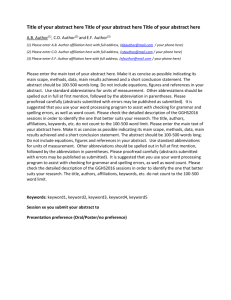
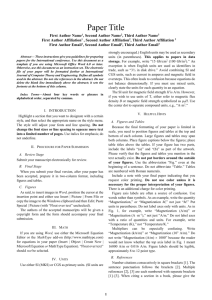

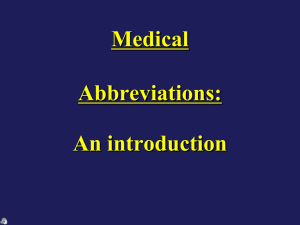
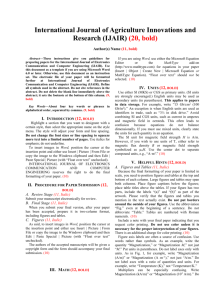
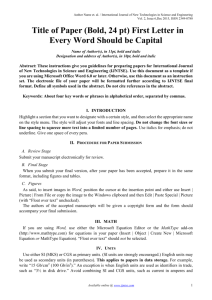
![Photoinduced Magnetization in RbCo[Fe(CN)6]](http://s3.studylib.net/store/data/005886955_1-3379688f2eabadadc881fdb997e719b1-300x300.png)

